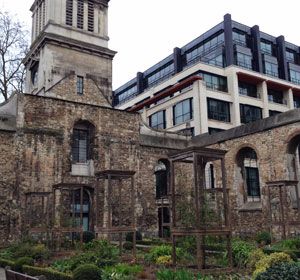Advent Day 13 - Greyfriars in London
Posted on
If you walk around near St Paul's Cathedral then chances are you'll stumble on the exposed ruins of the church of Christ Church Greyfriars. Today it's a public space, offering a space for workers in the surrounding offices to sit and have lunch among trailing vines and flowerbeds. But it used to be an important centre of worship in Medieval London, and the final resting place of several Queens of England.
The Medieval Priory
The church started life as a Franciscan monastery in the 13th century, which grew in popularity so quickly that a larger building was built in it's place in the early 14th century. The biggest sponsor of this new building was Queen Marguerite, a Princess of France and second wife of King Edward I of England. Marguerite and her niece, Queen Isabella (wife of Edward II), were both buried in this church. The earlier building had also received the heart of Eleanor of Provence, another former Queen of England, which was moved to the new building.
Despite their Royal patronage and support from the nobility (members of the Hastings, de Vere and Devereux families were all buried here), the church fell victim to Henry VIII's Reformation. The monastery was dissolved in November 1538. The monastery buildings were converted in to private houses, while the church was looted before spending several years as a Royal storage area. However the need for a church for the local Parish meant that the church building was cleared out and donated to the City of London, and reopened as a place of worship 1547, albeit stripped of many of its monuments (including, presumably, the Royal tombs).
Great Fire of London
Like St Paul's itself, Grey Friars church was completely destroyed by the Great Fire of London 1666. It was included in the list of churches to be rebuilt by Sir Christopher Wren, and merged with the nearby parish of St Leonard's, which was not replaced. Although the church was built on the foundations of the old building, it was smaller than the one it replaced. It was completed in 1687, with additions to the tower finished in 1704. Further work was carried out in the 18th century, including the installation of stained glass.
The congregation began to dwindle in the early 20th century as people moved out of central London and commercial buildings began to replace homes. The neighbouring institution of Christ's Hospital School was relocated to Sussex, leading to a further drop in numbers as the schoolboys were no longer brought to the church of services.
The Blitz
On 29 December 1940 the church once again burned down, along with seven other Wren churches in the area. The firebomb hit the roof, the ensuing fire led to the vaulting and roof collapsing in to the nave. An unknown postman reportedly ran in to the building and saved the carved wooden font, but everything else inside the church was destroyed.
After the war the Church of England reviewed all the Parishes in London, Greyfriars wasn't the only church to have been affected by dwindling congregations. In the following years the Parish was merged with St Sepulchre-without-Newgate, and while Greyfriars wasn't rebuilt, it was designated a Grade I Listed Building. The tower had to be dismantled and rebuilt in the 1960s to make it safe, and in 1989 the nave became a public garden. Today the tower is a private residence, but the nave is still public space, and has been complemented by carefully tended plants kept inside the remaining walls.